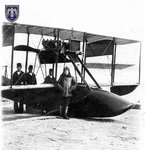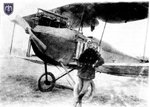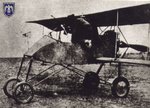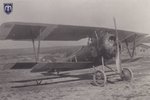Good stuff!
Navigation
Install the app
How to install the app on iOS
Follow along with the video below to see how to install our site as a web app on your home screen.
Note: This feature may not be available in some browsers.
More options
You are using an out of date browser. It may not display this or other websites correctly.
You should upgrade or use an alternative browser.
You should upgrade or use an alternative browser.
Turkish Air Force
- Thread starter gekho
- Start date
Ad: This forum contains affiliate links to products on Amazon and eBay. More information in Terms and rules
More options
Who Replied?- Thread starter
- #42
The USA firm Glenn Curtiss Airplane Motor Company was the leader in seaplanes in 1910s. Model F is the first of these series and it made its first flight in 1911. This was followed by MF-2 which made World demostration tour in 1914. The plane piloted by John Dale Cooper also came to Istanbul and made demostration flight. The military authorities who were greatly impressed with the air show bought the plane for 2000 liras in gold. It is the first seaplane that joined the Turkish AF. In 1915 during the Gallipoli Campaign while going to Chanak it had an accident. Eventhough it was repaired, it was left out of service since the previous performance was not obtained.
Attachments
- Thread starter
- #43
The DFW C.V produced by Deutsche Flugzeug Werke GmbH is one of the most successfull two-seaters of the WWI. They were produced in large numbers and they were assigned to reconnaissance, artillery coordination and guidance of the land forces. They started being deployed in 1916 and remained in service until the end of the War. In 1918 28 examples were sent to Turkey to arm the german flying units within the Empire. Two of these planes (factory numbers 4480 and 4482) were received from from the German units and they were given to the Turkish units in Konya in November 1918. Serials of the others are not known.
Attachments
- Thread starter
- #44
Designed by Mr.De Havilland DH-9s were produced by the British firm Aircraft Manufacturing Co.Ltd.. It is an advanced version of DH-4 and they entered service in Great Britain in 1916. 4 examples served the Turkish Aif Force. The first example was a Greek DH.9 whose pilot landed near Kuşadası due to fuel shortage after loosing his way back before the Battle of Sakarya. Pilot Vecihi (Hürkuş) and Chief Mechanic Eşref (Koçman) were sent to to repair the plane and fly it to the Turkish lines. The plane was repaired in ten days time and it was flown by Vecihi first to Ankara and then to the headquarters of the 2nd Airplane Co. located at Malikeuy. This plane was named İsmet after the commander of the Western Front and it served throughout the War of Independence. The other three were captured at Seidikeuy airport after the liberation of Izmir on Sptember 9, 1922. At the Alsancak Railroad station parts and spares good enough to make 10 DH.9s were found packed and stored within wagons. They remained in service until 1925.
Attachments
- Thread starter
- #45
The single seater Deperdussin and the double seater Deperdussin-D models produced by the French firm of the same name are the first planes of the Turkish Air Force. The Cabinet decided to purchase airplanes due to consistent pressure applied by the Supreme Commandorate of The Armed Forces but since there was no budgetary allocation the subject was taken to The Association of National Assistance by Mahmut Shevket Pacha, the Grand Vizier. Pacha himself added 30 liras in gold to the donations of the association. Other personalities including Prince Celaleddin of Egypt and Sultan Mehmet Rechad also contributed and three planes two of which were single seaters and the third a double seater were purchased. One of the planes was named Ottoman and the other Prince celaleddin to commemorate his contribution. The plane called Prince celaleddin fell near Yaffa on March 14th, 1914 while making the historic İstanbul-Cairo flight and the commander Nuri died. The Depperdussins were left out of service in 1914.
Attachments
- Thread starter
- #46
FIAT R.2 was two seated reconnaissance biplane designed by Celestino Rosatelli and produced by FIAT. They became operational in 1918. A total of 129 examples were produced. A businessman from Erzurum called Nafiz Bey (Kotan), a patriot, bought 4 R.4s from the Italians and a donation to the nationalist goverment to buy two more planes. He ordered his that the planes should be brought to Istanbul by maritime vessels and then they would secretly be flown to Anatolia to join the Nationalist Forces.
A relay type airfield should be m prepared in Bolu since it was decided hat the planes should fly to Eskisheir. The first plane was flown by an Italian pilot to Bolu but it was damaged during landing. The second plane came to Bolu with a 10-day delay. During training flights its propeller and the landing gear were broken. The remaining two planes were secretly carried to Polatlı on land. There they were repaired by the spares brought from Istanbul via Inebolu and they were put into flyable position and they were assigned to 1st Airplane Co.. Both of them participated the Battle of Sakarya. One was lost burning on flight on August 18,1921 during the Battle of Sakarya and both of the crew were killed. The other plane was also lost during the following events of the War of Independence.
A relay type airfield should be m prepared in Bolu since it was decided hat the planes should fly to Eskisheir. The first plane was flown by an Italian pilot to Bolu but it was damaged during landing. The second plane came to Bolu with a 10-day delay. During training flights its propeller and the landing gear were broken. The remaining two planes were secretly carried to Polatlı on land. There they were repaired by the spares brought from Istanbul via Inebolu and they were put into flyable position and they were assigned to 1st Airplane Co.. Both of them participated the Battle of Sakarya. One was lost burning on flight on August 18,1921 during the Battle of Sakarya and both of the crew were killed. The other plane was also lost during the following events of the War of Independence.
Attachments
- Thread starter
- #47
Fokker D.VII is accepted as the best German fighter of the WW1 era by the authorities. The first test flights were flown by Baron Manfred von Richtofen. But he never had the chance to pilot this plane in aerial combat due to his death soon before the plane became operational in April 1918. One of the famous pilots who flew this plane was Hermann Göring who would be the commander general of Luftwaffe during WWII. The D.VIIs proved themselves to be superior to the British and French planes of 1918. In addition to Fokker they were also produced by Albatros and OAW (Ostdeutcshe Albatros Werke). A total of 7 examples were deployed at the Ottoman armed forces. The deployment date is October 1918. All of the planes were assigned to 9th Airplane Co. and to 6th Airplane Co. but they were sent to be stored at the Maltepe warehouse due to armiastice ending the War.
Attachments
- Thread starter
- #48
Fokker E-1 Eindecker which is a copy of Morane-Saulnier Parasol was designed and produced by Fokker Flugzeug-Werke GmbH and they entered service in 1915 at the German Luftwaffe. The plane was the first one equipped with a synchrohised machine gun that could fire through the blades of the propeller. Eventhough it had a relatively slow speed it became the sovereign of the skies due to her high maneuverability. His sovereignity was ended with the arrival of new planes such as SPAD and Nieuport. In the following years advanced models called E-2, E-3 and E-4 were produced. Yhe most famous of all the pilots who flew E-1 was Max Immelmann who created the air maneauver on this plane. A total of 54 Fokker E-1s were produced 4 of which were deployed at the Ottoman Armed Forces from 1915 to 1917.
Attachments
Good shots!
- Thread starter
- #50
It is a tandem seated training and reconnaissance plane without any armament designed by Rumpler Flugzeugwerke in 1913. Its production started in 1914 by Rumpler and also under licence by Hannoversche Wagonfabrik. Only 198 examples were built because of its underpowered engine. The production was later on continued with the advanced C-1 model. 18 B-1s served the Ottoman Armed Forces as military aid from Germany starting on 1915. They remained in service until 1918.
Attachments
- Thread starter
- #51
The French firm Compagnie Gabriele Voisin designed and produced three different versions of light bombers all of which were equipped with a single engine and pusher propellers. The first one was Voisin.3. The plane which was equipped with a 100HP Renault engine entered service in 1914. The engine was changed with the more powerful Salmson M9 which was 120HP. This was followed by Voisin.5 in 1915. Voisin.5 was equipped with a 150HP Salmson P9 as standart engine. The last version to go into service was Voisin.8 the deployment of which took place in 1916. It was powered by an 220HP Peugeot. Voisin.5 is the most produced model with 300 examples. Until 1916 they served in the Western Front.
The two Voisin.%s in the Ottoman armed forces were ex-Russian planes which were captured in April 1918 in ther Eastern Front. They were assigned to the 7th Airplane Co. but they were lost on September and November 1918.
The two Voisin.%s in the Ottoman armed forces were ex-Russian planes which were captured in April 1918 in ther Eastern Front. They were assigned to the 7th Airplane Co. but they were lost on September and November 1918.
Attachments
- Thread starter
- #52
One of the most successful and best liked of the newly introduced C type armed two-seaters which appeared during 1915 was the C.I of the Rumpler Flugzeug-Werke. At first equipped only with a Parabellum machine-gun for the observer, the armament was later reinforced by the addition of a Spandau machine-gun for the pilot. By October 1916 there were some 250 C.Is and C.Ias in service. They were used as general-purpose types, and when they became outclassed on the Western Front they served in the Salonika, Palestine and Macedonian theatres during the 1917 period. They were also used on training duties in Germany right up to the end of the war. In fact, during 1918 a special trainer version with dual control was developed by the Bayerische Rumpler-Werke. This version was powered with a 150 h.p. Benz engine and did not have a gun-ring installation in the rear cockpit.
Eight new C.Is were transported to Damascus in the spring of 1917 and were to play a big part in the battles which took place that year for Gaza. All enemy troop movements were observed by the Rumplers and the General Staff kept constantly informed. Bombing raids were carried out on Allied cavalry. A total of 10 C.Is were deployed at the Ottoman Armed Forces till the end of the War including the 8 mentioned above.
Eight new C.Is were transported to Damascus in the spring of 1917 and were to play a big part in the battles which took place that year for Gaza. All enemy troop movements were observed by the Rumplers and the General Staff kept constantly informed. Bombing raids were carried out on Allied cavalry. A total of 10 C.Is were deployed at the Ottoman Armed Forces till the end of the War including the 8 mentioned above.
Attachments
- Thread starter
- #53
An urgent need of the British Admiralty for a torpedo carrying seaplane led Horace Short and Brothers to design the Short Model 184. The outcome was a very popular plane of the coming twenty years. More than 900 examples of this plane were built. Most probably it was the most produced seaplane of the WW1 era. It was laid on the design table on 1913 and the first prototype flew in 1915. The early models were eqipped with 225HP Sunbeam Maori engines. On the future models the engine was replaced by more powerful 240HP Renault or 260HP Sunbeam engines. It waas the first torpedo carrying seaplane in the World. It was also the first plane to sink a ship with an air launched torpedo. The event took place on the Sea of Marmara on August 15, 1915 and a Turkish 5000-ton cargo ship was sunk by a torpedo launched from a 184. Towards the end of the War they were assigned to maritime reconnaissance duties. The 184s were also capable of being catapulted from ships. The only example in possession of the Ottoman Armed Forces was a British plane that was forced to make an emergency landing due to ground fire while trying to bomb TCG Yavuz (ex. Goeben) on January 28, 1918. There are no official records of its repair and servixe within the Ottoman armed forces.
Attachments
- Thread starter
- #54
Nieuport 24 is an advanced model of the famous WW1 French scout Nieuport 17. It entered service in 1917 and it was followed by Nieuport 27. In fact neither Nieuport 24 nor Nieuport 27 took active duty in the War of Independence. The only example was captured from the retreating Greek Forces after the Great Offensive in Izmir-Gaziemir airfield in September 1922. They were named Ganimet-4 and Ganimet-5.
Attachments
- Thread starter
- #55
n 1928 TuAF planned to purchase 20 Potez 25-A2s. Before the procurement serial numbers 651 to 670 were allocated for this model. But it was decided later on to buy one for evaluation and comparison with Breguet XIX. Since the evaluation tests were not found sucessfull the purchase never realised. The only plane was deployed at the Operational Training Company where it remained in active service since mid-1935.
Attachments
- Thread starter
- #56
In 1926 TuAF organized a competition for the procurement of new fighter planes. Three firms from France and two firms from Germany participated. They were namely as follows:
* Nieuport Delage 42C 62................. (France)
* SPAD 51, 56 61............................. (France)
* Dewoitine D21C-1............................... (France)
* Rohrbach Rofix.............................. (Germany)
* Junkers A35................................... (Germany)
Rofix and A35 were found insufficient and they were eliminated. The French planes which were composed of 2 of Nieupport Delage 42C, 3 of SPAD 61 and 2 of Dewoitine D21C-1 were bought for further evaluation at the operational units. In 1927 further 10 Dewoitines were purchased. The planes were deployed at the 10th Hunter Co., 41st Hunter Co., and 42nd Hunter Co.. They remained in active duty until 1936 then they were replaced by PZL P-24s.
* Nieuport Delage 42C 62................. (France)
* SPAD 51, 56 61............................. (France)
* Dewoitine D21C-1............................... (France)
* Rohrbach Rofix.............................. (Germany)
* Junkers A35................................... (Germany)
Rofix and A35 were found insufficient and they were eliminated. The French planes which were composed of 2 of Nieupport Delage 42C, 3 of SPAD 61 and 2 of Dewoitine D21C-1 were bought for further evaluation at the operational units. In 1927 further 10 Dewoitines were purchased. The planes were deployed at the 10th Hunter Co., 41st Hunter Co., and 42nd Hunter Co.. They remained in active duty until 1936 then they were replaced by PZL P-24s.
Attachments
- Thread starter
- #57
It is a reconnaissance plane whose production started in 1928 in the Soviet Union. They remained to be in front-line service until mid-1941. A delegation headed by Marshall Voroshilov from the Soviet Union came to Turkey to participate the 10th anniversary celebrations of the Turkish Republic. Together with the delegation three Polikarpov R.5s and a PS-9 ( Double engined ANT-9) came to Turkey. After the celebrations the planes were donated to the Turkish Goverment. The Polikarpov R-5s were assigned to the Application Training Company. The planes called Erpet by the Turkish aviators were very much liked but due to lack of spares they were shortly written off.
Attachments
- Thread starter
- #58
It is a monoplane with two reciprocating engines designed and produced by the British firm General Aircraft Ltd. Its production started in 1935. Turkey purchased two planes which were received in October 1937. One of the planes (M.1/3215) crashed and the other one was dropped from active duty in 1941.
Attachments
- Thread starter
- #59
It is a trainer produced by the French Compagnie des Avions Henriot. The first model H-180T (Nr.1) made its first flight in 1934. Within the same year it participated the Salon de lAeronautique in Paris and and it won admiration with her modern lines. Models H-182.01, H-190M H-191 were produced in accordance with the demands of the customers. They also served the Republicans during the Spanish Civil War. 36 of them were deployed at the TuAF in 1940 together with the Morane-Saulnier fighters. The first 19 had camouflage painting whereas the remainder silver colored metallic bodies. They served the Aviation School until they were transferred to the Regiments as liaison planes in 1943. 5 were lent to the THK. They were dropped from active duty in 1945.
Attachments
Matt308
Glock Perfection
Great pics!
Users who are viewing this thread
Total: 1 (members: 0, guests: 1)
Similar threads
- Replies
- 4
- Views
- 493

















